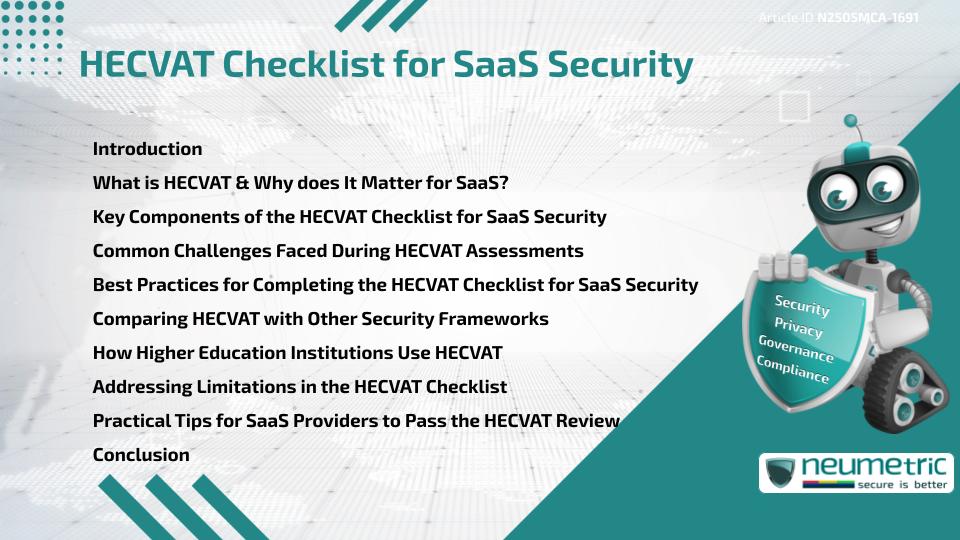Table of Contents
ToggleIntroduction
In today’s data-driven education environment, Software-as-a-Service [SaaS] providers must meet rigorous security expectations. One Framework that has become central to higher education vendor assessments is the Higher Education Community Vendor Assessment Tool [HECVAT]. Designed to evaluate a vendor’s Risk profile, the HECVAT checklist for SaaS security helps institutions ensure their Third Party tools align with security & Privacy standards.
This article explores the purpose, structure & use of the HECVAT checklist for SaaS security. Whether you are a SaaS provider targeting universities or an IT team reviewing vendors, understanding this tool is essential for trust, Compliance & continued collaboration.
What is HECVAT & Why does It Matter for SaaS?
The HECVAT was created by the Higher Education Information Security Council [HEISC] in collaboration with EDUCAUSE. Its primary goal is to simplify & standardize the vendor Risk Assessment process for colleges & universities.
For SaaS Providers, the HECVAT checklist for SaaS security functions like a security report card. It evaluates whether your service meets expectations for Data Privacy, Access Control & cloud safety. By completing the HECVAT, vendors can demonstrate readiness & responsibility to institutional buyers.
Key Components of the HECVAT Checklist for SaaS Security
The HECVAT checklist for SaaS security is structured around multiple categories, including:
- Data Handling: How personal or institutional data is collected, stored & transmitted.
- Security Controls: Measures such as encryption, multi-factor authentication & Incident Response.
- Compliance: Adherence to frameworks like FERPA, HIPAA or GDPR.
- Business Continuity: Backup procedures & Disaster Recovery capabilities.
- Application Architecture: Whether the app uses secure APIs & follows software development Best Practices.
Each section includes specific yes/no questions & documentation requests. These allow institutions to assess your service’s trustworthiness before moving forward.
Common Challenges Faced During HECVAT Assessments
Many SaaS vendors encounter challenges when completing the HECVAT checklist for SaaS security:
- Overlapping Terminology: Questions may resemble other frameworks but use unique phrasing.
- Documentation Gaps: Smaller vendors may lack the written Policies required.
- Compliance Misalignment: Some SaaS tools are built for commercial clients, not academia.
- Time-Consuming Process: The full version can take several days to complete thoroughly.
Despite these issues, preparation & internal coordination make the process manageable. Mapping existing controls to HECVAT categories is one of the best ways to start.
Best Practices for Completing the HECVAT Checklist for SaaS Security
Here are some practical tips for making your HECVAT experience smoother:
- Use the Lite Version First: For new engagements or simple integrations, start with HECVAT Lite.
- Assign an Internal Owner: A single point of contact helps ensure consistency in responses.
- Map to Other Frameworks: Link your answers to SOC 2, ISO 27001 or NIST CSF to strengthen credibility.
- Keep Records Centralized: Maintain a shared folder with all referenced documentation.
- Engage with IT Security Teams: Proactive communication builds trust with your academic clients.
Comparing HECVAT with Other Security Frameworks
While HECVAT shares similarities with frameworks like NIST CSF or ISO 27001, it has a more focused lens:
- Scope: HECVAT is specific to the needs of higher education.
- Audience: Its questions reflect common institutional concerns such as FERPA Compliance & data residency.
- Format: It’s structured as a questionnaire, unlike some certification-heavy frameworks.
SaaS Providers who already meet SOC 2 or ISO standards will find it easier to complete the HECVAT checklist for SaaS security. Still, direct mapping is not always perfect.
How Higher Education Institutions Use HECVAT
Colleges & universities typically request a completed HECVAT checklist before approving a new SaaS vendor. Some schools host public portals listing vendors who have passed their HECVAT reviews.
This process helps reduce duplicated work. Once a vendor completes the checklist, it can be reused across multiple institutions—saving time & effort for everyone.
Addressing Limitations in the HECVAT Checklist
Despite its benefits, the HECVAT checklist for SaaS security has limitations:
- Lack of Depth in Some Areas: It may not assess technical security details like Penetration Testing.
- One-Size-Fits-All Format: Not all SaaS tools fit neatly into its assumptions.
- Manual Review: There’s no automation or scoring, making assessments subjective.
Nonetheless, these limitations can be overcome by supplementing the checklist with additional documents such as Risk registers, architectural diagrams or Audit reports.
Practical Tips for SaaS Providers to Pass the HECVAT Review
To improve your chances of a successful review:
- Stay updated with changes in HECVAT versions.
- Benchmark with peer vendors or associations.
- Seek early feedback from clients or test reviewers.
- Offer transparent explanations for any non-compliant answers.
Following these steps will help you position your product as a secure, reliable partner for academic institutions.
Conclusion
The HECVAT checklist for SaaS security is an essential tool for Organisations aiming to ensure that their SaaS Providers adhere to critical security & Privacy standards. By thoroughly evaluating vendor practices, such as data handling, encryption & Compliance with regulations, the checklist enables Organisations to identify & address potential Risks. While it provides a solid foundation for assessing security, it is crucial to remember that Continuous Monitoring & regular updates are necessary to address emerging Threats. A proactive & holistic approach to SaaS security will ensure long-term protection of Sensitive Data & help Organisations maintain robust Security Measures.
Takeaways
- The HECVAT checklist for SaaS security is vital for doing business with higher education.
- It standardizes vendor assessments around Privacy, security & Compliance.
- Documentation & transparency are key to building trust.
- Despite its limitations, the checklist opens doors to long-term institutional partnerships.
FAQ
What is the HECVAT checklist for SaaS security?
It’s a standardised questionnaire used by universities to assess the security & Compliance of SaaS vendors before procurement.
Who needs to complete the HECVAT checklist for SaaS security?
Any SaaS provider looking to sell to higher education institutions should expect to complete this checklist.
Duration to complete the HECVAT checklist?
The full version can take several days, while the Lite version may take only a few hours depending on preparation.
Is the HECVAT checklist for SaaS security mandatory?
It’s not legally required but is often mandatory as part of a university’s procurement & IT Risk processes.
What happens after submitting the HECVAT checklist?
The institution’s IT or security team reviews it & may request clarification or supporting documents.
Can existing Compliance Certifications help?
Yes. Certifications like SOC 2, ISO 27001 & NIST CSF can make it easier to complete the checklist.
Difference between HECVAT Lite & HECVAT Full?
HECVAT Full is detailed & suited for high-Risk systems. HECVAT Lite is for low-Risk applications or pilot use.
Are responses to the HECVAT checklist confidential?
Generally, yes. However some institutions may seek permission to share your filled Questionnaire with other peer universities.
Is there a fee for submitting the HECVAT checklist for SaaS security?
No. The checklist is a free tool created by & for the higher education community.
References
Need help?
Neumetric provides organisations the necessary help to achieve their CyberSecurity, Compliance, Governance, Privacy, Certifications & Pentesting goals.
Organisations & Businesses, specifically those which provide SaaS & AI Solutions, usually need a CyberSecurity Partner for meeting & maintaining the ongoing Security & Privacy needs & requirements of their Clients & Customers.
SOC 2, ISO 27001, ISO 42001, NIST, HIPAA, HECVAT, EU GDPR are some of the Frameworks that are served by Fusion – a centralised, automated, AI-enabled SaaS Solution created & managed by Neumetric.
Reach out to us!


